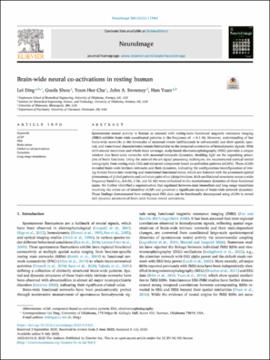| dc.contributor.author | Ding, Lei | |
| dc.contributor.author | Shou, Goufa | |
| dc.contributor.author | Cha, Yoon-Hee | |
| dc.contributor.author | Sweeney, John A. | |
| dc.contributor.author | Yuan, Han | |
| dc.date.accessioned | 2022-10-17T20:21:04Z | |
| dc.date.available | 2022-10-17T20:21:04Z | |
| dc.date.issued | 2022-10-15 | |
| dc.identifier.citation | Ding, L., Shou, G., Cha, Y.H., Sweeney, J.A., Yuan, H., 2021. Brain-wide neural co-activations in resting human.Neuroimage, 2022, 119461, https://doi.org/10.1016/j.neuroimage.2022.119461. | en_US |
| dc.identifier.uri | https://hdl.handle.net/11244/336544 | |
| dc.description.abstract | Spontaneous neural activity in human as assessed with resting-state functional magnetic resonance imaging (fMRI) exhibits brain-wide coordinated patterns in the frequency of < 0.1 Hz. However, understanding of fast brain-wide networks at the timescales of neuronal events (milliseconds to sub-seconds) and their spatial, spectral, and transitional characteristics remain limited due to the temporal constraints of hemodynamic signals. With milli-second resolution and whole-head coverage, scalp-based electroencephalography (EEG) provides a unique window into brain-wide networks with neuronal-timescale dynamics, shedding light on the organizing principles of brain functions. Using the state-of-the-art signal processing techniques, we reconstructed cortical neural tomography from resting-state EEG and extracted component-based co-activation patterns (cCAPs). These cCAPs revealed brain-wide intrinsic networks and their dynamics, indicating the configuration/reconfiguration of resting human brains into recurring and transitional functional states, which are featured with the prominent spatial phenomena of global patterns and anti-state pairs of co-(de)activations. Rich oscillational structures across a wide frequency band (i.e., 0.6 Hz, 5 Hz, and 10 Hz) were embedded in the nonstationary dynamics of these functional states. We further identified a superstructure that regulated between-state immediate and long-range transitions involving the entire set of identified cCAPs and governed a significant aspect of brain-wide network dynamics. These findings demonstrated how resting-state EEG data can be functionally decomposed using cCAPs to reveal rich dynamic structures of brain-wide human neural activations. | en_US |
| dc.description.sponsorship | Financial support was provided by the University of Oklahoma Libraries’ Open Access Fund. | en_US |
| dc.language | en_US | en_US |
| dc.rights | Attribution-NoDerivatives 4.0 International | * |
| dc.rights.uri | https://creativecommons.org/licenses/by-nd/4.0/ | * |
| dc.subject | cCAP | en_US |
| dc.subject | EEG | en_US |
| dc.subject | Brain states | en_US |
| dc.subject | Global co-(de)activations | en_US |
| dc.subject | Dynamics | en_US |
| dc.subject | Long-range transitions | en_US |
| dc.title | Brain-wide neural co-activations in resting human | en_US |
| dc.type | Article | en_US |
| dc.description.peerreview | Yes | en_US |
| dc.identifier.doi | 10.1016/j.neuroimage.2022.119461 | en_US |
| ou.group | Gallogly College of Engineering::Stephenson School of Biomedical Engineering | en_US |





